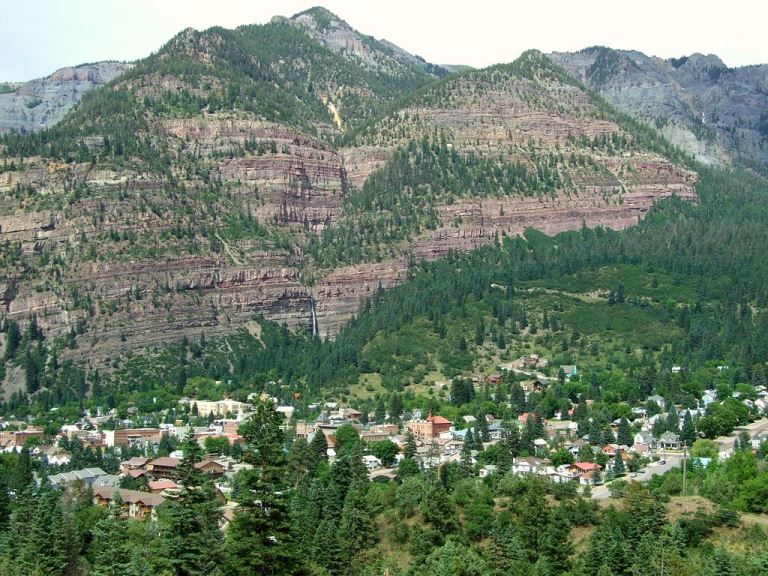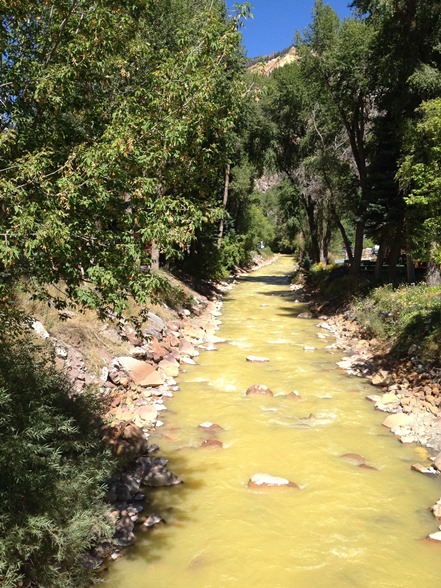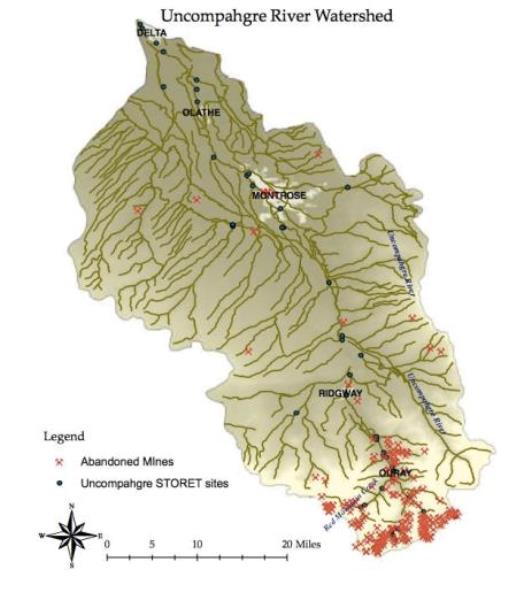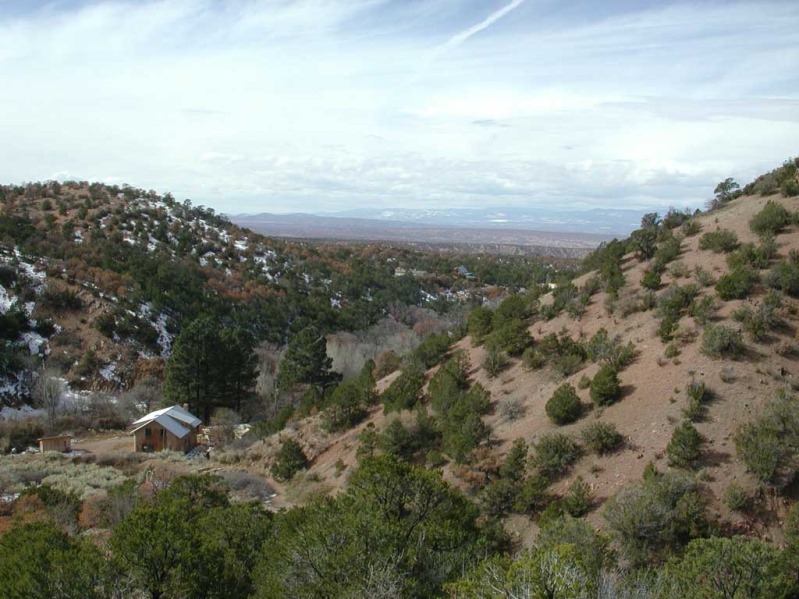 As my husband and I drove into Ouray, Colorado recently, we both gasped. The red-grey cliffs of 14,000-foot mountains cradle the old mining town, with waterfall lacework tracing down the mountainsides — one of the most gorgeous spots on Earth. But it was the stream tumbling through the valley we were gasping at: It was yellow, only a few shades less intense than the Tang color of the Animas River when mine tailings had poured into it earlier this summer. Has there been a spill here that I haven’t heard about? I thought, horrified.
As my husband and I drove into Ouray, Colorado recently, we both gasped. The red-grey cliffs of 14,000-foot mountains cradle the old mining town, with waterfall lacework tracing down the mountainsides — one of the most gorgeous spots on Earth. But it was the stream tumbling through the valley we were gasping at: It was yellow, only a few shades less intense than the Tang color of the Animas River when mine tailings had poured into it earlier this summer. Has there been a spill here that I haven’t heard about? I thought, horrified.
 I asked a server at a café, and she said first noticed the yellow color the day before, though she works so much that maybe it had been yellow longer than that. An authoritative-looking fellow, possibly the owner, said it was just the normal color, from “minerals” in the mountains. I asked him for the name of the river so I could google it, and he fumbled. He had to ask around to confirm that its name was the Uncompahgre.
I asked a server at a café, and she said first noticed the yellow color the day before, though she works so much that maybe it had been yellow longer than that. An authoritative-looking fellow, possibly the owner, said it was just the normal color, from “minerals” in the mountains. I asked him for the name of the river so I could google it, and he fumbled. He had to ask around to confirm that its name was the Uncompahgre.
My husband and I walked down to the river and noticed that thick yellow sediment had settled out in the eddies and that the rocks were stained to a foot above the waterline. Fall had turned a few trees yellow, forming an oddly lovely match with the water.
We saw a man in an official truck and asked him about the river. Yep, he said, totally normal color. Lots of iron in the soil — “Uncompahgre” means “red river” in Indian, he reported. I pointed out that the river was yellow, not red, and he shrugged. “It’s yellow from the beginning,” he said, “where it starts next to a tailing pond. Totally normal.” He asked where we were from, we chatted, and he waved as he drove away.
I googled and found an EPA report that pinned the high concentration of metals in the Uncompahgre River on mining activity from the 1870’s. It said that in 1983, Colorado sued the local mining company, the second largest silver producer in the US, and tried to make the mines a Superfund site; nine years later, a settlement led to some remediation. Nevertheless, the river continues to run yellow, with levels of cadmium, copper and zinc that are dangerous to aquatic life.
 Sitting by the river, I felt surrounded by what law professor Charles Wilkinson calls the “lords of yesterday”: laws or customs or beliefs that once made some sense but have carried over to today and become senseless. One such lord is the lack of any requirement for mining companies to pay royalties for the minerals they’ve extracted from federal land. If the companies had had to pay royalties for the past 150 years, there might be money available to do a decent cleanup of all the leaking mines abandoned after miners had extracted the wealth from the land.
Sitting by the river, I felt surrounded by what law professor Charles Wilkinson calls the “lords of yesterday”: laws or customs or beliefs that once made some sense but have carried over to today and become senseless. One such lord is the lack of any requirement for mining companies to pay royalties for the minerals they’ve extracted from federal land. If the companies had had to pay royalties for the past 150 years, there might be money available to do a decent cleanup of all the leaking mines abandoned after miners had extracted the wealth from the land.
Our mining laws have carried over from the Gold Rush mining camps in the late 1840s, and then they made a lot of sense. There were no federal or state laws there — California wasn’t even a state yet — but miners created their own rules, because they’d be damned if some other miner was going to come along and steal a gold-rich spot from them. Each camp settled on similar regulations: A miner could keep others off an area he was actively prospecting, and once he found gold, that land became his — to mine, to build a house on, to log, to run cattle, whatever. Any gold he managed to extract was his, free and clear. He certainly wouldn’t pay royalties. Heck, who would he even pay royalties to?!
The 1872 Hardrock Mining Law codified these rules, making the miners happy and the federal government along with them — after all, the Gold Rush brought the United States into the world economy. Despite 150 years of modifications, the core of that law is unchanged. If you find a valuable mineral on available federal land, the mineral is yours, and the land with it.
Another, even more powerful lord of yesterday seemed to be hovering over that yellow river as well. The 1872 Hardrock Mining Law grew straight from the English philosopher John Locke’s justification for private property from 250 years earlier, and that philosophy and spiritual vision of man’s relationship to the Earth continue to haunt us today. “God and his reason commanded men to subdue the earth, i.e., improve it for the benefit of life,” Locke argued. The earth was initially given to all men in common, he said, but land is nearly worthless before a man works it. Since all men own their own labor and working on land embeds that labor into the land itself, then land becomes yours when you work it. There is (or at least was) plenty of land for everyone, so taking some out of the commons deprives nobody. The land thus fairly belongs to he who works it.
 Locke’s argument fit with the European image of wilderness as desolate and frightening. Adam and Eve were thrown out of the tame, orderly Garden of Eden into the desert wilderness. In European mythology, demons and spirits lived in the wood. Wild was bad, tame was good.
Locke’s argument fit with the European image of wilderness as desolate and frightening. Adam and Eve were thrown out of the tame, orderly Garden of Eden into the desert wilderness. In European mythology, demons and spirits lived in the wood. Wild was bad, tame was good.
Gold Rush miners were exactly following Locke’s prescription, busting their backs to extract from the land what was beneficial to men. Of course the land and the minerals they extracted should be theirs, no strings attached.
Reading Locke brought me to tears. I built my own house in Santa Fe, on land completely undeveloped except for a single peach tree, a relic of a bygone orchard. I put enormous labor into my land, and yes, Locke has a point, all that effort does make the land feel like it belongs to me. But at least as much, it makes me feel that I belong to the land. Of course, I can choose to leave it, as I’m doing for nine months during my Ted Scripps environmental journalism fellowship in Boulder — but still, I feel a beating, living thread of responsibility and care attaching me to it, stretching across all these miles.
And the idea that my land was nearly valueless before I worked it — I shudder. It’s not just that the land provided a home for the great ponderosas I’ve come to love, that bears ate its peaches and birds ate its sumac berries, that water rolled off its hills and fed the stream. I feel like my land has value the way my dog has value, independent of anyone’s enjoyment of them. My land feels like a being to me, with a life, even a soul, of its own. I suppose I subscribe to the Native American creed: the Earth is alive.
 The straight line that connects Locke to the 1872 mining law continues arrow-like to the yellow river I was sitting by in Ouray. The acid tailings floating down the river weren’t only a natural consequence of the greed that lives naturally within us all, myself included. Without the notions of dominion, of the near worthlessness of undeveloped land, of the frightening quality of wilderness, we would have chosen a different course — at least a bit different. It’s hard to imagine that we would have torn up the hillsides and poisoned the streams quite so much had our creation myth described the first humans emerging from the earth at a spot nearby, as the Tewa Indians’ did. That’s true even if we no longer held that beautiful story to be the literal truth because the fossil record and the mutations of viruses had impressed upon us the power of evolution. Science doesn’t determine our deep, intuitive beliefs about our relationship to that which is bigger than any of us.
The straight line that connects Locke to the 1872 mining law continues arrow-like to the yellow river I was sitting by in Ouray. The acid tailings floating down the river weren’t only a natural consequence of the greed that lives naturally within us all, myself included. Without the notions of dominion, of the near worthlessness of undeveloped land, of the frightening quality of wilderness, we would have chosen a different course — at least a bit different. It’s hard to imagine that we would have torn up the hillsides and poisoned the streams quite so much had our creation myth described the first humans emerging from the earth at a spot nearby, as the Tewa Indians’ did. That’s true even if we no longer held that beautiful story to be the literal truth because the fossil record and the mutations of viruses had impressed upon us the power of evolution. Science doesn’t determine our deep, intuitive beliefs about our relationship to that which is bigger than any of us.
As I watched the water tumble over the rocks, I thought, Spirituality matters. Being an atheist doesn’t exempt you from this, nor are spirituality’s impacts ooshy-gooshy things that may or may not exist. They’re visible in the yellow of the creek, the brown of the beetle-killed ponderosas sprinkled across the cliffs, the black ink of our laws.
For a moment, I wanted to travel through time, to grab John Locke’s scrawny neck and haul him here to look at the river his ideas had turned the color of piss. But then I thought, no, John Locke isn’t the problem. The problem is us, that our laws, our beliefs, our spirituality are immature and inadequate. The problem is that we continue to relinquish our authority and responsibility for the challenges of today to the lords of yesterday.
_______
Julie Rehmeyer is a freelance math and science writer and contributing editor at Discover; most recently she won an award for excellence in statistical reporting from the American Statistics Association.
_______
Photo credits:
Ouray and John Locke portrait, via Wikimedia Commons: The Uncompahgre River, by Julie Rehmeyer; Old mine sites in the Uncompahgre watershed, from an EPA report; Julie’s house & land by Julie herself
For anyone curious about how it is that mines pollute rivers, check out this superb explainer Jonathan Thompson wrote for High Country News about it: http://www.hcn.org/articles/acid-mine-drainage-explainer-animas-pollution-epa-gold-king
I’m relieved to see that it doesn’t make anything I wrote above wrong, but I would have loved to have found it earlier.